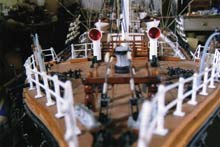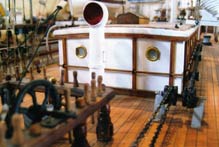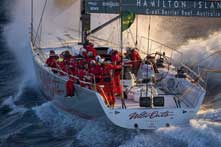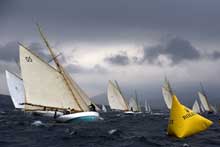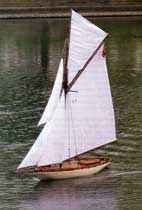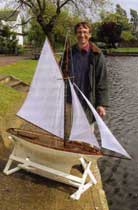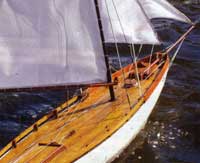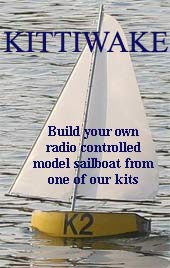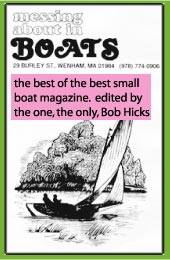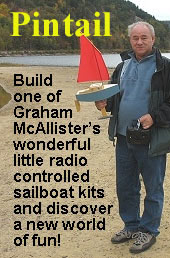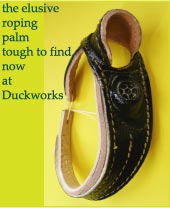Of model shipwrights and just sailors of model yachts,
and sometimes the twain doth meet!
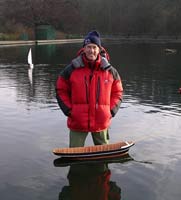 |
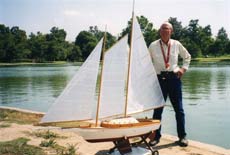
Left, Nev Wade, above `Swede’ Johnson. |
This is a subject rather dear to my heart, one whereby I can understand and offer a measure of support to both sides. It is one where the man who takes year upon year upon year to complete a model sailing boat, in the process fashioning every single often minute item (sometimes twenty or thirty of the same!) will often find it hard to relate to another whose prime interest is to just sail and therefore has a key objective of building it as quickly as possible, often from a kit with a grp hull. It is sometimes an affront to the purist who is indeed a `model shipwright’ to read references to the other as such, but not quite fair (I don’t think) to confine the latter’s attitude and interest to the garbage dump.
We are all different with different objectives and we all possess different tastes, abilities and skills, and blessed are those with the aptitudes and the patience and time to take several years to build a model ship that is a wondrous example of that persons knowledge and abilities and is often too good to place on the water. Ian Hunt is one such person. Turn to sailors however, many of them with the building skills perhaps but who want to start sailing and or don’t have an abundance of time and I can appreciate their need to either kit-build and/or quick-build in order to start enjoying their sailing. Indeed if it were not for the availability of such `buy, assemble and enjoy’ models on the market today, (some might refer to them as cheap and nasty) and I contend that there would be fewer people enjoying model sailboating today.
There are of course many people who have the aptitude to build and build well, and who build their often very detailed model sailing boats with the objective of sailing them, and many of these are indeed like Ian Hunt, excellent model shipwrights. People like Mark Tindall of England, Richard Mayes of Queensland, Australia, `Swede Johnson of the USA, Wim Moonen of the Netherlands, Andreas Gondesen of Germany and Neville Wade of the UK.
Ian Hunt in Australia is another, he is nearing completion of his massive Sindia, and if you look at the first three photos below you will agree.
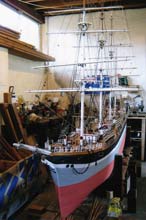
|
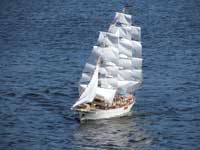
Rick Mayes Sea Cloud |
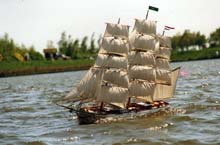 Moonen’s Drommen
Moonen’s Drommen
|
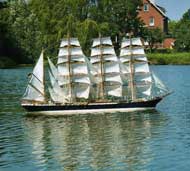 Gondesen’s Pamir
Gondesen’s Pamir |
Another year will soon have bitten the dust, that time again to wish every one of you whose eyes might wander through Where the winds blow, the very best of seasonal greetings, with the bonus expression of hope that next year will be a healthy one for you. Here is another absolutely stunning photograph (below) by Carlo Borlenghi of the start of the Classic fleet’s race at Les Voiles de Saint Tropez in 2006, a ROLEX Carlo Borlenghi image. The man is good, no question about it! Borlenghi was on hand off Sydney’s coast again to capture this dramatic shot of the eventual Rolex Sydney to Hobart 2007 Yacht Classic line honours winner. Wild Oats. X1 (see second picture below) You can almost hear the whoosh of water, feel the aft spray just looking at the image. The final photograph is of Neville Crichton’s new Alfa Romeo, the race record smasher and line honours winner in the Rolex Giraglia classic, which starts in St Tropez, France and concludes at Genoa in Italy. Taken by the same photographer at a time when most photographers are either at the bar or in bed. It is a memorable image indeed.
Here is a trio of stunning photos by Carlo Borlenghi, (below right), the start of the classic fleet’s race at Les Voiles de Saint Tropez in 2006. The man is good, no question about it and he was again on hand for Rolex off the coast of Sydney, Australia to capture the dramatic shot (below left) of the eventual Sydney to Hobart 2007 line honours winner, Wild Oats X1. You can almost hear the whoosh of water, feel aft spray just looking at this image! Then there is the larger photo of Neville Crichton’s Alfa Romeo taken by Carlo Borlenghi in the Rolex Giraglia Classic which starts in St Tropex, France, concludes at Genoa in Italy. I think it is a superb image. All three photos are by Rolex/Carlo Borlenghi.
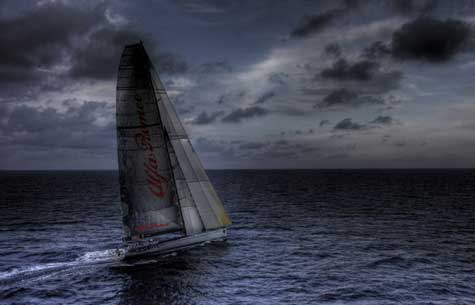
The brilliant photography of Carlo Borlenghi
Back to Australia where Rick Mayes a wee while back built and sailed boats at the young age of sixteen. Now aged 'sumpety- sumpin' he well remembers the occasion captured in the first photo below of he and friend, Randal Johnson in the saltwater pool in Brisbane with two of his boats of the period. The schooner Rebel and the Tiki (both built without plans out of Balsa, using Tarzan’s Grip for glue. The Tiki was inspired by the TV series Adventures in Paradise and was Rick’s first working model without the benefits of radio control. The photo at right is of Rick’s Southern Starlet, the lower left photo of a Footy sailed by Paul Kiah in Titusville, Florida with the Sand Point Model Sailing Club fleet, the lower right photo of the little kit-built Footy Freya complete with skipper and pet pooch which makes a good little simple to assemble `starter boat’ for the young, that is available from an import firm in Britain.
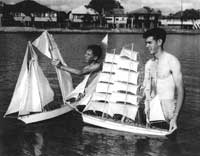
|
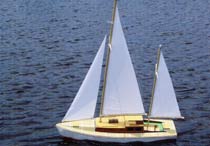 |
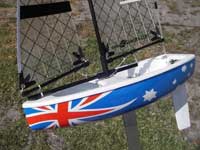
|
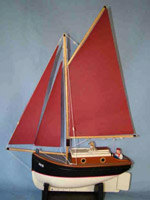 |
“Model sailboating of the windling kind,
generates relaxation, fosters patience
provides time for appreciation of the boats,
tweaks the adult imagination, and
develops friendship with likeminded others.
Were I a `squillionaire’ I would
still choose to sail model yachts with our Ancient Mariners,
and would want
to be treated just the same as I am treated now,
as a friend and fellow windler”
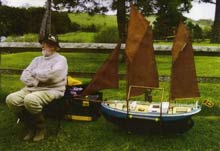
|
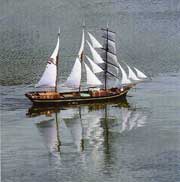 |
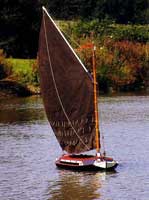
|
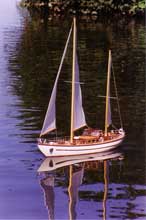 |
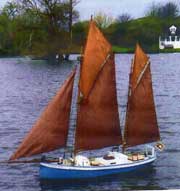
|
John Berridge is an Englishman almost the same age as the writer who lives in North Devon in Britain. He has always practiced some form of modelmaking, mostly model aircraft with a few boats when he was a lad. When radio control emerged it was exclusively model aircraft, his first model flown in 1955. Now, he describes himself at 74 as one who has never really grown up (he thinks) `as a result of playing with toys’. John worked as a Mechanical Fitter at the Portsmouth Power Station, was sent to college for 5 years gaining a Higher National Diploma in electrical engineering , did his National Service as a radar mechanic and retired early at 56 from a post as a grid control engineer in the South West of England, retirement giving him plenty of time to devote to modeling activities.
John has built some lovely looking models, a few of which I have seen before and featured in Windling World, like the 60” LOA pearling lugger, Georges Bizet (seen with John in the top left photo). This was built using a paper and emulsion technique. One of his latest builds is the Inkerman Smallbones, a model of a wooden barquentine of about 1900 (top right photo) with square sails controlled independently of the fore and afts, Then there is the Norfolk Wherry used in years gone by on the rivers and Broads of East Anglia, a shallow draught vessel used for cargo, crewed usually by one man and one boy (shown in the middle photograph above left). John who like my other mate, John Butterwith sails with the Kenwith Castle Model Boat Club has also built the ketch Daddies Yacht (fourth photo above right) photo above left which was a Graupner kit. In the last photograph (above - right in centre pair), the ketch-rigged pearl boat Georges Bizet is seen on the waters of the lake at that venue.
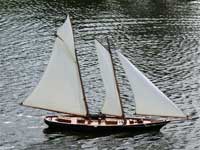
|
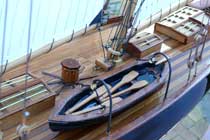 |
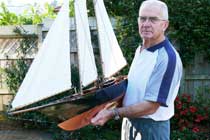
|
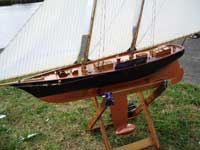 |
On the day that Duckworks Publisher, Chuck Leinweber visited the Ancient Mariners sailing water, Laurie Manning launched his model of America (seen above) and what an absolutely superbly built model it turned out to be. The fullsize America needs hardly any introduction and is probably one of the most famous yachts ever. In 1851 a schooner called AMERICA sailed around the Isle of Wight in UK, beating 14 other yachts to win the Hundred Guinea Cup. The crew donated their trophy to the New York Yacht Club and thus the AMERICA’s CUP was born. America, often described as one of the most beautiful yachts in the world is today the worlds most famous racing yacht. The original boat sadly was destroyed during World War II housed dockside and crushed by a heavy snowfall. Laurie Mannings model, for which he was awarded the Great Schooner Model Society trophy is seen above and I stake my opinion that it is quite the best ever model of America that I have ever seen. Look closely at the photos, you may see why.
The Christmas Present!
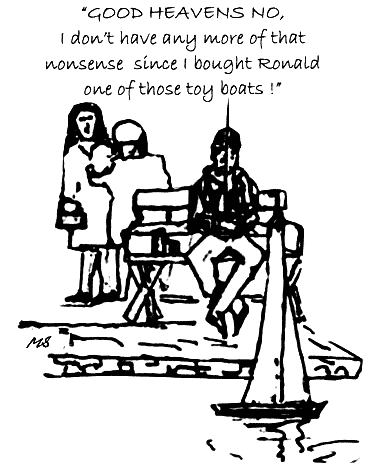
The world seems always in lunatic mode and in a rush, strikes me it needs to have automatic brakes fitted to everything and to every one of us. George Catlin wrote, `We’ve learned to rush, but not to wait’. He also said, `we’ve learned to make a living, but not a life!’
Geoff Dixon writing in the February issue of the British Marine Modelling International, wrote of his friend John’s rescue and rebuild of a very old sailing boat from the breakers yard, a model that he (John) used to borrow from his Dad, a graceful old pond yacht now the best part of a hundred years old
John well remembered taking the yacht to the sea front in Southend in a pram on occasions, and on one being showered with apples when the mast caught in a tree.
Asked to restore it, Geoff originally declined as the deck of the model was badly split and the hull was only barely sound. and requiring of extensive work if the model was ever to sail again. After much sanding back and extensive work by John, his request to fit radio control could not be ignored by Geoff who undertook to help on a `beer for work done’ agreement. With new sails, a quarter scale Hitec rudder servo and a Hitec sail winch, the construction and fitting of bulwarks and new brass fittings, the old yacht now renamed The Henry Grant, sails again.
There is something about the old English pond yacht that is absolutely enthralling, and so enthusiastic has Geoff become, he is now looking around for a similar old yacht to restore and then sail (I’ll bet there will be a race or two!) with his friend John, perhaps beer being the spoils of victory! Now that is both typical (and admirable) of the gentlemanly sporting spirit of an Englishman!
Some months ago I threw in a question as to whether us older guys sailing model sailboats should be giving consideration to a training model to attract youngsters to the hobby of ours, an idea conceived by friend Bill , a mate-never-met of mine in Mass, USA. Well the response was terrific (and I am also an equally terrific teller of porkies!). The fact that nobody even uttered a solitary `dickie bird tweet’ suggests that many followers of this column either only look at the pictures, or they lean toward my personal opinion expressed, that for many of us older guys this is our quality time which we should continue to enjoy to the max. Many who are youngsters today, at some stage of their lives will get tired of and leave their blasted computers, and once attracted to model yachts some may then go sailing.
On that note, each and every one of you: have a happy Christmas.
|



